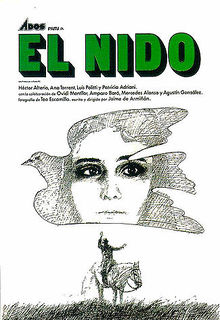
EL NIDO
Spain, 1980, 97 minutes, Colour.
Ana Torrent, Hector Alterio.
Directed by Jaime de Arminan.
El Nido was nominated for Best Foreign Film Oscar for 1980. It is a very well made, moving and involving film. It is the unusual story of a widower and his infatuation/friendship with a teenage girl. She appears innocent on the surface but is evil within. She moves the widower to destruction. The film is very well acted, especially by Ana Torent, the child star of Anna and the Wolves, Raise Ravens and The Spirit of the Beehive. The film may be seen as excellent human drama, but also should be seen in the light of the Spanish film industry revival and its allegorising after the passing of the Franco regime.
1. The film's acclaim? Qualities? Impact?
2. The Spanish film industry in the late '70s: colour photography, use of locations, acting, musical score?
3. The structure of the film: the introduction to the widower, his style of life, the explanation of his background, his recluse behaviour? The next stage ? the encounter with the girl, the infatuation and friendship? The next stage ? their friendship. her seduction of him. bending him to her will, his executing her will. his seeking understanding from mistress, confessor? The final stage of his succumbing to death on her behalf?
4. Insight into human relationships: identity, vulnerability, attraction. manipulation, motivation, disaster?
5. The portrait of the widower? his experience, age? The background of his marriage and life? Seminary years, marriage? His recluse way of life? His love of music and conducting it? The comforts of his home? His relationship with his mistress? His conversations with the parish priest and the warm bonds of their friendship? His listening to his advice? Values and problems of belief in God? Memories, self-understanding? His encounter with the girl and his being touched, infatuated, friendly? His being bewildered? Drawn out of himself? Their shared interests and the lyrical way in which these were presented? The birds, the nest? His making the pact with the girl? Her gradual power over him and his allowing it? How much did he realise? His burning the past? His being tempted to kill? His being possessed by her, the final discussion with the parish priest as a kind of final confession? The siege? His death and his having no bullets in his gun? The pathos of his destruction?
6. The girl and her charm, her delightful appearance and manner, her friendship with the widower? The daughter of the policeman? Her lifestyle in the village? A young recluse? Her behaviour and the way that it was filmed ? our being seduced in a way similar to the widower? Her work at school, the teacher's remark about her being Lady Macbeth? Innocence and experience? Enchanting and an enchantress? Tempting the widower, manipulating him? The pact and its solemnity? Her exercising her power to destroy? The shared interests of the birds and the nests? Her eagle in the cage ? real, symbolic? Her absence and his sense of being abandoned? Her return? Her changing? Her growing cruelty? Her final urging him to kill and being responsible for his death? Her evil, selfishness, motives?
7. The symbols of the birds. the nests, their behaviour. freedom, eagle in the cage. its release?
8. The sketch of the teacher and her relationship) to the widower? Her insight into the girl? A possible bond of reality for the widower?
9. The parish priest and his views, friendship, the visits of the widower, ease, discussions, confession? Faith? The memory of the seminary days? The parish priest and his warning his friend?
10. The housekeeper and the other minor characters ? the sense of reality, support for the widower?
11. The policeman, the reality of the village, relationship with his daughter, the men at the police station? Law, justice?
12. The importance of music - for background, the texture of the film? The relationship of the widower to music and his conducting it? Its harmony with nature?
13. A portrait of twisted human relationships? An allegory of Spanish society?